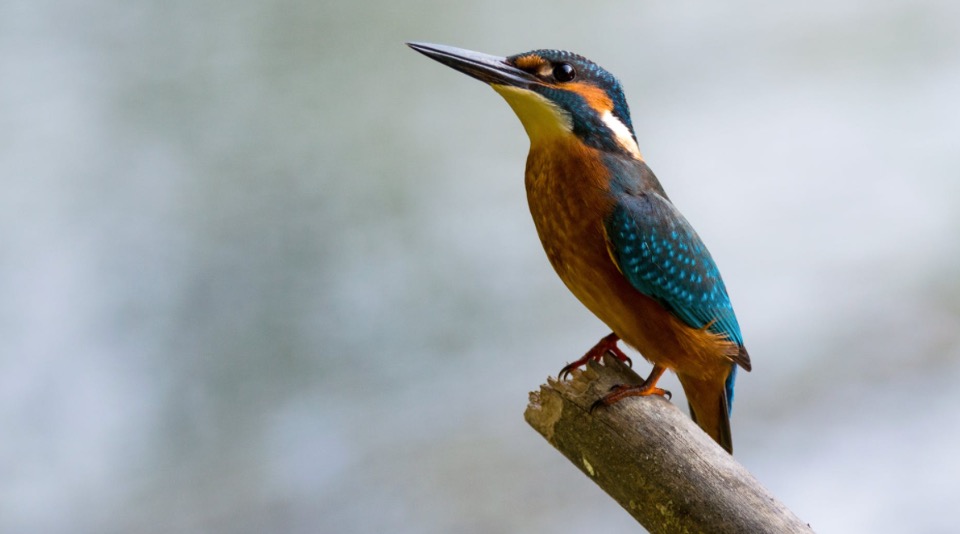Kingfisher Classification
- Kingdom: Animalia
- Phylum: Chordata
- Class: Aves
- Order: Coraciformes
- Family: Alcedinidae
- Genus: various

Kingfisher Description
Kingfishers are one of the medium-sized birds having fish-feeding behaviour. The family of kingfisher in further classified into three subfamilies or categories named as Halcyoninae, Alcedininae, and Cerylinae.
The Halcyoninae or tree kingfishers are the largest group including 12 genera, all the American kingfishers are included in the category Alcedininae, and all water kingfisher particularly from Africa, Southeast Asia, and Australia included in the category Cerylinae.
Kingfisher Appearance
Usually kingfishers are medium- sized birds. They consists long pointy bills that helps them to capture fish and other prey. The smallest species is African dwarf kingfisher (Ispidina lecontei), which is about 3.9 inch long with 9-12 g weight whereas Megacaeryle maxima or the giant kingfisher is considered as the largest species having 255- 426 g weight and 17- 18 inch length.
The Australian kingfisher or the laughing kookaburra (Dacelo novaeguineae) found in Africa is recorded much heavier than the giant kingfisher weighing up to 500g. The common European kingfisher and most of the other species consists bright plumage of green, blue, and orange hues.
The bills in most species are also long, and sharp. The legs are short having four toes on each foot and the eyes are dark brown in color. Kingfishers usually have an excellent vision thus they are able to spot their prey from a great distance.
Their eyes have membranes that cover and protect their eyes during hunting fish underwater. For example, in the pied kingfisher a simple membrane is present with a boney-plate that slides across its eye when it hits the water instead.
Kingfisher Distribution and Habitat
Kingfishers are distributed in all over the world but exists in most temperate and topical regions in the world. However, in Americas, a few species are found that are restricted to very small regions. However, the common kingfisher and belted kingfisher occur frequently.
Some species such as the common kingfisher has a wide range of distribution, which occur throughout Europe, North Africa, Asia, and the Solomon Islands whereas some other species are endemic to particular range or a single island, for example the Kofiau paradise kingfisher lives on an island near New Guinea.
The habitats of kingfishers also occupy various ranges. However, they are named as solely fish- eaters, but only less than half of the total species live on rivers and lakes while some other species can tolerate dry conditions and live in deserts.
Many species live in the mountains and forests while some species adapted themselves to live in human-developed areas. However, not all the species adopted themselves to live in human- developed areas thus, it also poses threat to their habitat’s existence.
Kingfisher Prey and Predators
Kingfishers are called fish-eaters due to the fact that they eat fish. They have very aggressive and speed hunting tractics, which they use to hunt fish with their sharp bills. Besides fishes some other species eat a variety of other prey such as frogs and lizards, insects, mollusks, and even snakes.
While most of the water kingfishers are fish eaters. Various animals including foxes, wild cats, and other animals feed upon the kingfishers thus they are vulnerable to predation by these any animals.
Due to their speed and sharp bills, their hunting is difficult but the young kingfishers and eggs are eaten by other animals. The domestic cats, and raccoons also possesses threat to kingfishers.
Kingfisher Nesting and Reproduction
Kingfishers generally form monogamous breeding pairs thus they are known as territorial organisms. However in some species such as the laughing kookaburra practice a cooperative breeding strategy. In this strategy the dominant breeding pair raise their young ones with the assistance of helpers.
All the kingfishers form their nests in tree cavities or holes in banks of a river. Several species also form their nests in termite nests and lay between 2-10 small eggs. Nest- building and incubation duties done by both males and females.
The young kingfishers remain with their parents for about 3-4 months after hatching. The life span of kingfisher is usually about 15 years. Most of the species are threatened by human- developed areas, however, some species are also adapted for human- developed areas but most of them are forest dwelling.
Thus their habitats are continuously disappearing due to deforestation. Some species including Marquesan kingfisher are listed as critically endangered species.
Fun Fact about Kingfisher
For centuries, Kingfishers has captured the imagination of humankind, however they are relatively shy and elusive in nature. Kingfishers have so many interesting facts including their beautiful plumage and the less obvious feeding habits of some species.
i. How do Kingfishers get so bright?
Kingfishers consists bright feathers and plumage due to the unique structural characteristics of their feathers. The structure scatter the blue light that provide brightness. However, in some exceptional cases such as the American green kingfishers use iridescence or semi- iridescence to produce brilliant shine. The way is also used by peacocks to gain their luster.
ii. The physicist bird
The kingfishers dive at rapid speeds to catch small fish and generally hunt fishes underwater that swims just below the surface. They have the capability of compensating for the refraction of light in water. They can also assume the depth of the prey swimming underwater. They use all mechanisms to hunt their prey using stealth and surprise.
iii. More than a fisher
Kingfishers are also famous for their long, dagger-like bills. They use the bills to capture fish, however, several species have shorter and broader bills that helps them to hunt their prey from the ground. For example insects and small mammals. The shovel- billed kookaburra (Clytoceyx rex) have the special shaped bills that helps it to dig through debris and dirt of the forest floor.
Kingfisher Citations
- Belted Kingfisher (Megaceryle alcyon): https://www.audubon.org/
- Belted Kingfisher Identification: https://www.allaboutbirds.org/







